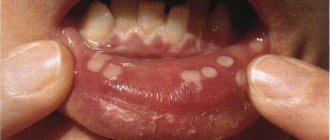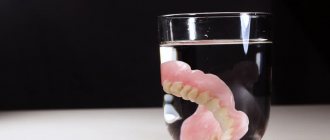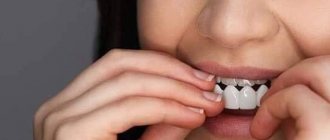Various types of tests and examinations can help identify health problems. One of the best ways to understand what problems exist in the internal organs is to conduct magnetic resonance imaging (MRI). However, there are certain contraindications for patients who cannot undergo MRI examinations. Quite often questions arise about whether people wearing braces can undergo MRI diagnostics. Read on to find out in what cases it is allowed and in what cases it is not for those who wear an orthodontic device to undergo an MRI examination.
Is it possible or not to do an MRI with braces on teeth?
Magnetic resonance imaging can be performed with braces on the teeth, however, when performing diagnostics, it is necessary to take into account some nuances:
- what material is the orthodontic structure made of?
- what part of the body is exposed to magnetic influence;
- Are there alternative diagnostic options?
MRI of the brain
It is possible to do an MRI of the brain with braces. In the manufacture of most modern orthodontic systems, metals are not used, which can affect the outcome of the diagnosis. It is necessary to check with your dentist exactly what alloys were used to make these braces.
Some metals may resonate with the magnetic field during diagnostic testing. This will result in the study being slightly biased. Therefore, it is important to have an idea of the technology for making corrective plates and, based on this, evaluate the feasibility of tomography.
With retainers installed
Retainers are thin metal plates that are installed on the inside of the tooth after the bite is corrected with braces. In most cases, they do not affect brain MRI readings.
Important!
Studies have shown that multi-wire retainers did not cause significant distortions in diagnostic results.
If tomography is performed in another area, the patient may not worry about the reliability of the results. With braces and retainers, they cannot be distorted, since the structures do not enter the magnetic field space.
Non-reactive material
Regardless of which part of the body will be examined on a tomograph, the patient must inform the specialist about the presence of metal braces or other devices made of this material . If the specialist has such information, he will reconfigure the device, thereby ensuring sufficient quality of the procedure.
Modern dental products are predominantly made from polymers that do not react to magnetic radiation and do not distort the examination result.
In this case, the magnetic field always reacts with metals, but the strength of this interaction is influenced by their physical and chemical characteristics.
It is possible to perform a body examination using MRI if the orthodontic system is made of the following materials:
- titanium and its alloys;
- ceramics (without the use of steel grooves);
- plastic;
- ferromagnets; iron, cobalt, nickel, chromium and rare earth metals from thulium to gadolinium.
Important: if the patient experiences discomfort or other negative signs during the procedure, he must press the panic button to stop the process.
How do metal parts react when examined in a tomograph?
There is a stereotype that tomography cannot be done with metal braces. Reviews from some patients indicate that the structure is attracted by a magnet, heats up, emits harmful substances and can completely deteriorate. These myths are supported by people's imagination, since none of the hypotheses have been confirmed.
On a note!
A person with braces does not feel anything unusual during an MRI of the head. The examination is the same as without orthodontic construction. Nothing gets hot, explodes or gets damaged.
What to do if the results are distorted
If braces cause distortions in the images, it is possible to conduct a second examination or, if possible, use another diagnostic method. In some cases, this examination method can be replaced by another diagnostic method, for example, computed tomography. In extremely rare cases, radiologists insist on removing braces if the risk of obtaining unreliable results is too great. In any case, the presence of such a system is not an absolute contraindication to diagnostics. But to obtain the most accurate information after diagnosis, it is necessary to warn specialists about their presence.
Patient misconceptions about the effect of magnets on braces
Some patients refuse the procedure because they consider MRI and a retainer (braces) to be incompatible. Main misconceptions:
- if you do a magnetic examination with an orthodontic design, the result will be unreliable, and the examination itself will be useless;
- the magnetic tomography device affects the tension force of the corrective arc, after which the staples become useless;
- when exposed to a magnetic field, the metal releases toxic substances that are dangerous to humans;
- when manipulated, the plates heat up and can peel off from the tooth;
- a magnet can attract locks and arches, so doing an examination is dangerous.
Important!
None of the assumptions has a scientific evidence base, so they are all considered patient misconceptions. If there are concerns about the effectiveness and safety of this diagnosis, it is worth listening to the opinions of several specialists.
Method information
MRI in medicine is considered the safest and most effective diagnostic method, which allows doctors to accurately and quickly determine the location, severity of the disease, and any abnormalities in the functioning of the human body.
In short, magnetic resonance imaging is a scan of the human body, and unlike CT or radiography, it operates on a slightly different principle.
This technique is based on the interaction of the magnetic properties of human tissue and an artificially created magnetic field.
Thanks to this interaction, the condition of cartilage, soft tissues, organs, brain, spine, and ligaments is assessed extremely accurately. That is, those structures of the body that contain a large volume of liquid are examined.
This diagnostic technique is the most effective for the early detection of malignant neoplasms, inflammation, disorders in the central nervous system, joints, spine, musculoskeletal system, pelvic and abdominal organs, and blood vessels.
The advantages of the technique include:
- Possibility of obtaining a more detailed image of the object being examined.
- It is possible to examine those places in the body where the use of CT will be ineffective.
- There is no ionizing radiation to the patient.
- It provides not only a detailed image of the structure of an organ/tissue, but also displays the degree of its functioning.
- You can perform an examination with the introduction of a contrast agent, which significantly increases the diagnostic potential.
- An unmistakable examination result.
To carry out the procedure, special equipment is used: a powerful computer and a tomograph (scanning device of a closed, partially closed, or completely open type).
Open-type tomographs are usually used to examine obese people, as well as those who suffer from attacks of claustrophobia.
Depending on the area of the area being examined, the duration of the procedure is 30-60 minutes. (in some cases up to 2 hours).
The images are interpreted by a radiologist, but in special situations, highly specialized specialists are involved in the interpretation of the image.
Before the examination, the patient is asked to remove all or part of his clothing (it all depends on the area of study). If some items of clothing are allowed to remain, it is important to remove all metal objects from pockets.
An alternative method of examination with braces is CT
Computed tomography is an alternative to magnetic scanning. The main difference between them is that MRI uses magnetic influence, while CT uses X-rays.
You can do a CT scan with braces. Orthodontic treatment is not a significant contraindication for examination. The only nuance that experts take into account is the material used to make the correction system. During an x-ray, it can be recorded by the system. Therefore, when interpreting the results, it is necessary to pay attention to the error. Automatic interpretation of results may be distorted and show a pathological process where it actually does not exist.
MRI machine
The device is equipped with a camera, which is placed in a special pipe. The patient is placed on a retractable table before he is immersed in a chamber - a tube. As soon as the examination begins, the image obtained by irradiating the patient with electromagnetic waves is immediately displayed on the monitor screen, which is located near the device itself. To obtain a clear image in the photograph, the patient is urged to lie still during the examination period (approximately 15-20 minutes). Using an MRI machine, tumors, pathologies and anomalies of internal organs are detected.
Reviews
In the capital, almost every medical institution has a tomograph and everyone is examined indiscriminately. When I was scheduled for pelvic diagnostics, I had braces. I thought that the procedure would be postponed until the end of treatment or the plates would be removed ahead of schedule. But the doctor convinced that the braces would not interact with the magnetic field, since it affects a completely different area.
Inna, Moscow
They ordered a head examination, and I had braces. There was no time to wait, since a dangerous diagnosis was in question. I found out from the dentist that my braces are made of plastic and there are no metal parts in them. Therefore, I did the procedure without fear and did not regret it. The primary diagnosis was not confirmed.
Egor, Krasnodar
Common Misconceptions
Among patients themselves and on Internet forums, you can come across a lot of statements regarding the compatibility of MRI examination and braces.
Many of them are shocking with negative consequences for human health, others talk about obtaining a 100% inaccurate result. Much of the information is inaccurate and unsubstantiated.
The most common misconceptions are:
- During examination, the metal becomes quite hot and magnetized , causing the structure of the braces to collapse. In reality, nothing like this happens. Magnetic radiation does not heat up the correction device, and the magnetization effect is so small that it is not felt.
- Metal parts may damage tooth enamel during examination .
Modern braces are small in size and cannot move and injure the oral cavity during the diagnostic process. Only large structural elements made entirely of metal can become very hot, move and cause injury to the oral cavity. But today, in the manufacture of large parts, paramagnetic materials, which are passive in relation to the magnetic field, are usually used. - The result of the study will be greatly distorted .
This statement is only half accurate. Braces can affect the results and interfere with the diagnosis of only the part of the body in which they are installed. Therefore, if you perform an MRI of the head with an orthodontic system installed, the results will indeed be incorrect. In this case, radiography or angiography will be more informative. - During diagnosis, the patient feels electric shocks . In addition, they say that hot braces leave burns on the mucous membrane and soft tissues. In practice, not a single similar case has been recorded. The examination is absolutely painless.
Sometimes patients feel slight discomfort from lying on a hard surface for a long time, fatigue, and numbness due to being in one position for a long time. When a contrast agent is injected to confirm the diagnosis, you may feel cold during its administration.
Important! In isolated cases, there is a slight tingling sensation in the body, warmth in the examined area, slight dizziness, nausea, vomiting, and headache. These phenomena are considered in medicine to be a normal reaction of the body to the procedure.
The only negative consequence of MRI is a distortion of the actual picture of the patient’s health condition.
A physician will not be able to make an accurate diagnosis based on tomography data or select an acceptable treatment for a particular patient. The procedure does not pose any risk to the health, much less the life of the person being examined!
In the video, a specialist will express his opinion on the possibility of performing an MRI in the presence of braces.
Computed tomography in dentistry
Diagnostics using the latest tomograph in is your opportunity to conduct a high-quality CT scan of teeth in Kurkino, in a place convenient for you, where you can subsequently undergo the necessary treatment. We have installed advanced equipment Planmeca ProMax 3D with ProFace function. This 3D scanning system provides maximum information content of the obtained data, creating images of bone tissue layer by layer and with high clarity. If you need a dental CT scan in Khimki, our clinic in Kurkino, a neighboring district of Moscow, will offer you every opportunity to conduct a thorough analysis of the condition of the oral cavity in any projections.
How does the presence of braces affect the results of an MRI study?
With a computer examination of the lumbar region, upper or lower extremities, patients are not in danger - there will be no distortion of the clinical picture, much less pain. The situation is similar with examination of other parts of the body located away from braces.
The only problem awaits when examining the maxillofacial apparatus, as well as the brain, i.e. areas located close to the installation site of braces.
The restriction applies only to those structures that are made of metal-containing material . For this reason, before determining the advisability of an MRI, it is recommended to check with the orthodontist whether there is any metal in the structure. Based on the information received, a decision is made to perform an MRI.











